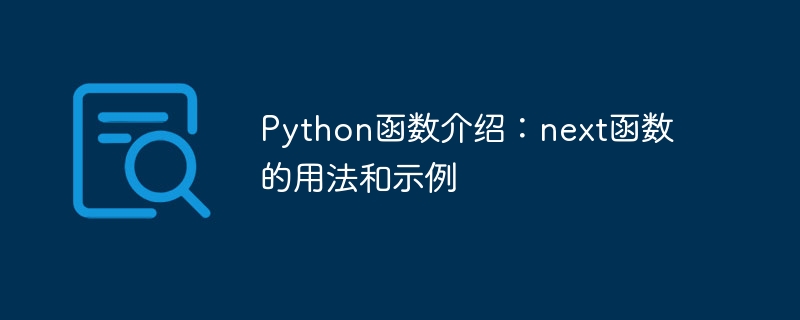Home >Backend Development >Python Tutorial >Introduction to Python functions: Usage and examples of next function
Introduction to Python functions: Usage and examples of next function
- 王林Original
- 2023-11-04 16:23:063551browse

Introduction to Python functions: Usage and examples of next function
Introduction:
In Python, functions are a very powerful tool that can help us Encapsulate code to achieve code reuse and modularization. In Python, there are many built-in functions that can be called directly, one of which is the next function. This article will introduce the usage of next function and provide some sample code to illustrate its practical application. I hope that through the explanation of this article, readers can better understand and use the next function.
1. Introduction to the usage of next function:
The next function is a built-in function of Python, which can be used to obtain the next element in an iterable object. When calling the next function, we need to provide an iterable object as a parameter and optionally a default value parameter. If there are still elements in the iterable object, the next function will return the next element; if the iterable object has no elements, the next function will report a StopIteration exception when no default value parameter is provided; when a default value parameter is provided, then Default value parameters will be returned.
2. Basic syntax of next function:
next(iterable[, default])
Among them, iterable is an iterable object, that is, an object containing a series of elements, such as characters String, list, tuple, etc.; default is an optional parameter, used to set the default return value when the iterable object has no elements.
3. Example code of next function:
-
Use next function for list
x = [1, 2, 3] it = iter(x) # 获取可迭代对象 print(next(it)) # 输出:1 print(next(it)) # 输出:2 print(next(it)) # 输出:3 print(next(it, "No more elements")) # 输出:No more elements
In this example, we first use iter function to convert the list x is converted to an iterable object it. Then, we call the next function three times to obtain the elements in the list one by one, outputting 1, 2, and 3 in sequence. Finally, we provide the default value parameter "No more elements" to avoid StopIteration exceptions when there are no more elements.
-
Using the next function of the generator
def fib(): a, b = 0, 1 while True: yield a a, b = b, a + b fib_gen = fib() # 创建一个生成器 print(next(fib_gen)) # 输出:0 print(next(fib_gen)) # 输出:1 print(next(fib_gen)) # 输出:1 print(next(fib_gen)) # 输出:2 print(next(fib_gen)) # 输出:3In this example, we define a generator function named fib, which can generate the Fibonacci sequence of every element. We get the elements of the Fibonacci sequence one by one by calling the next function and print them out one by one.
Conclusion:
Through the introduction of this article, we understand the basic usage of the next function, and demonstrate its actual application scenarios through sample code. The next function can flexibly traverse the elements of the iterable object, and can also set default value parameters to handle the situation after the iteration ends. I hope this article will help readers understand and use the next function. I also hope that readers can make good use of functions, a very important concept in Python, to improve the readability and maintainability of the code.
The above is the detailed content of Introduction to Python functions: Usage and examples of next function. For more information, please follow other related articles on the PHP Chinese website!

